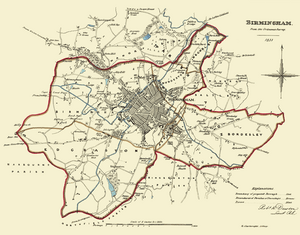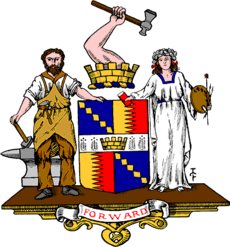Government of Birmingham facts for kids

This article is about how the city of Birmingham, England is governed. It explains how local decisions are made and how Birmingham is represented in the national Parliament.
How Birmingham's Government Changed Over Time
Most of Birmingham was historically part of Warwickshire. But the modern city also includes areas that used to be in Staffordshire or Worcestershire.
Before the 1760s, Birmingham was managed by local officials. These were often volunteers who worked part-time. As Birmingham grew, this system became too small. So, in 1768, a group called the "Commissioners of the Streets" was created. They could collect money to pay for things like street cleaning and lighting. Later, they also helped with policing and building public places.
In 1832, a law called the Reform Act gave Birmingham its first chance to send people to Parliament. At first, it had two Members of Parliament (MPs), but this number has grown over time.
Birmingham became a municipal borough in 1838. This meant it had its own elected town council. This council took over the jobs of the Street Commissioners. In 1889, Birmingham became a county borough and was officially called a city. This status meant it was a self-governing area.
Things changed in 1974 when Birmingham became a metropolitan district. It joined the new West Midlands county. The county council was later removed in 1986. After this, Birmingham mostly went back to running itself, like a unitary authority. However, it still shares some services with other areas in the county.
Birmingham received its official coat of arms in 1889. This symbol was updated for the city council in 1977.
In the past, the city council was in charge of things like water, electricity, and gas. They also managed colleges, public transport, and local police and fire services. Today, these services are run by other public or private groups.
How Birmingham Grew Bigger
Birmingham's borders expanded several times in the 1800s and 1900s.
When Birmingham became a municipal borough in 1838, it included the areas of Birmingham and Edgbaston. It also included part of Aston. In 1889, the municipal borough of Birmingham became a county borough.
More areas were added in 1891, like Harborne from Staffordshire and Balsall Heath from Worcestershire. Part of Aston parish, called Saltley, was also added. Quinton in Worcestershire joined in 1909.
A very big expansion happened in 1911. This was called the Greater Birmingham Scheme. It added Aston Manor and Erdington from Warwickshire. Handsworth from Staffordshire also joined. From Worcestershire, Yardley and most of King's Norton and Northfield were added. Perry Barr in Staffordshire joined in 1928. In 1931, parts of Minworth, Castle Bromwich, Sheldon, and a small part of Solihull were included. This included the area known today as Castle Vale.
On April 1, 1974, Birmingham was reorganized under a new law. It became a metropolitan district. This new area included both the old county borough of Birmingham and the municipal borough of Sutton Coldfield.
Birmingham's Representatives in Parliament
Birmingham sends people to the House of Commons in London. This is where laws are made for the whole country. These representatives are called Members of Parliament, or MPs.
Birmingham's first two MPs were Thomas Attwood and Joshua Scholefield. They were elected in 1832 after the Great Reform Act gave the town the right to have MPs.
Today, Birmingham has ten areas, called parliamentary constituencies. Each of these areas elects one MP. Currently, one MP is from the Conservative Party and nine MPs are from the Labour Party.
| Constituency | MP | Party | ||
|---|---|---|---|---|
| 1 | Birmingham, Edgbaston | Gisela Stuart | Labour | |
| 2 | Birmingham, Erdington | Jack Dromey | Labour | |
| 3 | Birmingham, Hall Green | Roger Godsiff | Labour | |
| 4 | Birmingham, Hodge Hill | Liam Byrne | Labour | |
| 5 | Birmingham, Ladywood | Shabana Mahmood | Labour | |
| 6 | Birmingham, Northfield | Richard Burden | Labour | |
| 7 | Birmingham, Perry Barr | Khalid Mahmood | Labour | |
| 8 | Birmingham, Selly Oak | Steve McCabe | Labour | |
| 9 | Sutton Coldfield | Andrew Mitchell | Conservative | |
| 10 | Birmingham, Yardley | Jess Phillips | Labour | |




